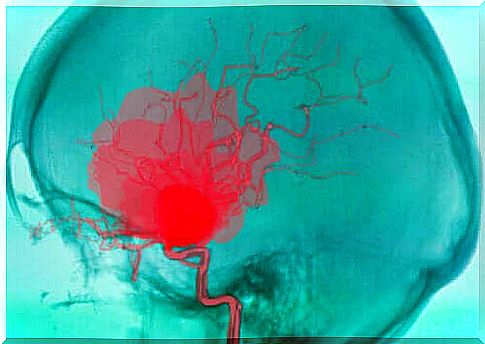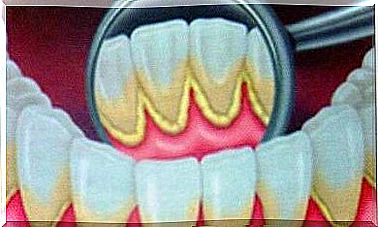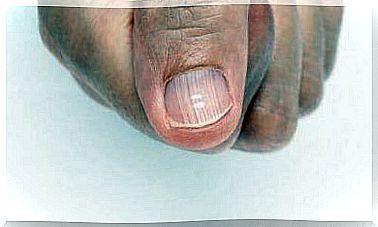What Exactly Is An Intracerebral Hemorrhage?

An intracerebral hemorrhage is a serious situation that can endanger a person’s life. It consists of bleeding in the brain. As a result, other parts of the body do not receive oxygen.
It is therefore the second leading cause of stroke. The problem is that, despite current treatments, the mortality from an intracerebral hemorrhage is still very high.
In addition, those who manage to survive are more likely to have disorders. The incidence of this condition increases with age. However, age is not the only risk factor. Let’s take a closer look at this.
What is an intracerebral hemorrhage?
An intracerebral hemorrhage, as we mentioned in the introduction, is a hemorrhage that occurs in the brain. It usually causes sudden neurological deficits and sometimes even coma.
This is due to the lack of blood supply to other parts of the brain (Spanish link), as the blood does not continue its journey through the blood vessels. It is important to distinguish between an intracerebral and an intracranial hemorrhage.
Intracranial hemorrhages, in addition to intracerebral hemorrhages, include others that occur in the skull but not in the brain parenchyma. For example, intraventricular, subarachnoid, subdural and epidural hemorrhages.
Intracerebral hemorrhage is one of the leading causes of stroke. In fact, experts estimate that nearly 15% of all strokes are caused by this condition. It also has a high mortality rate, especially in the early days.
Related Symptoms

As we have just explained, an intracerebral hemorrhage is usually associated with a neurological defect that occurs abruptly. Depending on the cause of the bleeding, it can happen very quickly (within one to two hours) or more slowly. The symptoms vary depending on the area affected.
As with ischemic strokes, loss of strength in one half of the body is common. In other words, if the bleeding has occurred on the right side of the brain, then the left legs and arms will be affected.
It is normal for the same side to lose sensitivity or for tingling to appear. It can also affect speech or the ability to understand language. A number of people lose sight in one eye (Spanish link).
Headaches, vomiting, loss of consciousness and even coma are common symptoms. Headaches and vomiting are usually associated with increased intracranial pressure as a result of the intracerebral hemorrhage itself.
The main causes of an intracerebral hemorrhage
This condition can occur for several reasons. Age is one of the most relevant factors. The incidence increases with age and is higher in men than in women.
The main underlying cause is high blood pressure or hypertension. This is because the cerebral arteries, which are small in size, are very sensitive to increased pressure.
Similarly, trauma can cause intracerebral hemorrhage. This is one of the reasons why it is more common in the elderly, who have a tendency to fall.
Another cause is cerebral amyloid angiopathy (Spanish link). It is a disease that consists of the build-up of certain proteins in the walls of the arteries of the brain. It causes recurrent bleeding as the arteries become more fragile.
Blood disorders, especially coagulation disorders, facilitate the development of intracerebral hemorrhages. In most cases, however, they are caused by the use of certain medications, such as anticoagulants.
They can also affect young people. For example, the use of drugs such as cocaine or amphetamine increases the risk. Similarly, arteriovenous malformations are another relatively common cause.
Therapy
An intracerebral hemorrhage is a medical emergency. If you suffer from any symptom or sign, you should seek medical attention immediately. The first thing doctors do is stabilize the patient. As with any other bleeding, it is essential that the patient does not go into shock.
Intubation is also often necessary, as it allows the patient to breathe adequately. Similarly, platelet concentrates or fresh frozen plasma can be administered to stop the bleeding. This is indicated if the patient has taken anticoagulants.
As the MSD Manual explains (Spanish link), vitamin K also helps reduce bleeding in these patients. In severe hypertension, blood pressure medication is indicated. However, this is very sensitive, because too much lowering of blood pressure can exacerbate the damage.
The patient may even require surgery, which consists of drawing the accumulated blood to reduce intracranial hypertension. Medical professionals use it in cases where the bleeding has caused progressive neurological deterioration or if it affects the brain stem.
Potential Complications and Prognosis

As we mentioned above, an intracerebral hemorrhage carries a high risk of death. In fact, experts estimate that the death rate is about 40% (Spanish link). Moreover, people who survive often face long-term problems.
Most complications arise from the expansion of the hemorrhage or the edema that develops around it. Because of the damage to the brain tissue itself from the lack of blood supply. The patient may have seizures and may develop communication and vision problems.
In addition, survivors often have severe headaches and loss of sensation and mobility. While the prognosis is poor, it varies depending on the severity of the bleeding.
Either way, most patients need therapy. Rehabilitation therapies can help improve speech or mobility or help the patient regain other functions.
An intracerebral hemorrhage is serious
Anyone who survives this type of bleeding must take into account certain aspects. From that moment on, for example, they have to keep their blood pressure under control. It is important that they adopt a healthy lifestyle to prevent another episode.
Elderly people with high blood pressure are at a very high risk of bleeding. They should therefore minimize the risk of falling and keep their medication under control.









